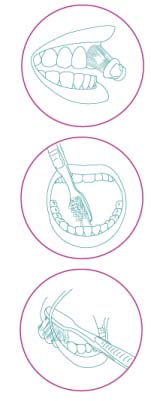For the health of our teeth and gums, it is imperative that we undertake regular at home oral hygiene practices, notably brushing and flossing. Keeping on top of your regular brushing and flossing will enable you to have healthier teeth and gums, that not only look better, but also feel better too!
As time goes on, we develop tartar and stain build up on our teeth. You may notice your teeth may become discoloured and that your gums may bleed when you brush and floss. This is due to the build up causing gum disease called gingivitis and may even progress to a more serious form called periodontitis.
At home we may prevent this build up with our brushing and flossing, but once it has formed, the only person who can remove this is your Dentist! Regular visits for a clean will remove this tartar and stain build up and allow your teeth and gums to remain healthy. Each individual has unique circumstances, and after consulting with Dr Rooein, he will inform you how often you need to return to have your teeth cleaned.
Formulating a good at home routine, along with regular visits to Dr Rooein, will give you every chance to have teeth that look and feel good for the rest of your life!

Basic Brushing
There are a few different methods considered acceptable when brushing your teeth. Whatever method you use, take the time to brush thoroughly with a recommended toothpaste every day. We recommend the following method to help maintain for dental health and easily getting rid of plaque:
1. Place the head of your toothbrush beside your teeth, with the brush tips at a 45O angle against your gum.
2. Move the brush back and forth in short, semi-circle strokes several times, using a gentle ‘scrubbing’ movement.
3. Brush the outer surfaces of each tooth, top and bottom, keeping the bristles angled against your gum.
4. Use the same method on the inside surfaces of all the teeth, still using short back and forth strokes.
5. It is important to brush the chewing surfaces of the teeth and they will be constantly in contact with everything you put in to your mouth.
6. You must also clean the inside surfaces of the front teeth by tilting the brush vertically and make several gentle up and down strokes with the front part of the brush.
7. You should not forget your tongue, brushing it will help freshen your breath and clean your mouth by removing bacteria

Basic Flossing
An essential part of your routine, flossing removes plaque from between the teeth, areas where gum disease can begin. It can sometimes feel a little awkward to floss, talk to your dentist and follow the tips below to help you feel more comfortable in maintaining your oral health.
1. Wind roughly 18″ of floss around middle fingers of each hand. Hold each end of the floss between your thumbs and index fingers, leaving about 1″ to 2″ of length in between. You should use your thumbs to direct the floss between your upper teeth.
2. Keeping the 1″ to 2″ length of floss nice and firm between fingers, use index fingers to direct the floss between the lower teeth.
3. Gently guide the floss between the teeth by using a zigzag motion. It is important to remember not snap the floss between your teeth but using a smooth and flowing motion around each side of the tooth.
4. Slide the floss up and down against your tooth surface and under the gum. This may feel awkward but it is important to get underneath the tooth to clean those areas. A separate piece of floss should be used for each tooth to clean them thoroughly.
Wouldn’t you prefer to prevent these problems instead of treating them?
Creating a simple daily hygiene routine can mean less visits to the dentist, little or no dental health issues and a bright, healthy smile full of your own teeth for life..
Save your money for the finer things in life, brush and floss twice a day and make sure you visit your dentist regularly







